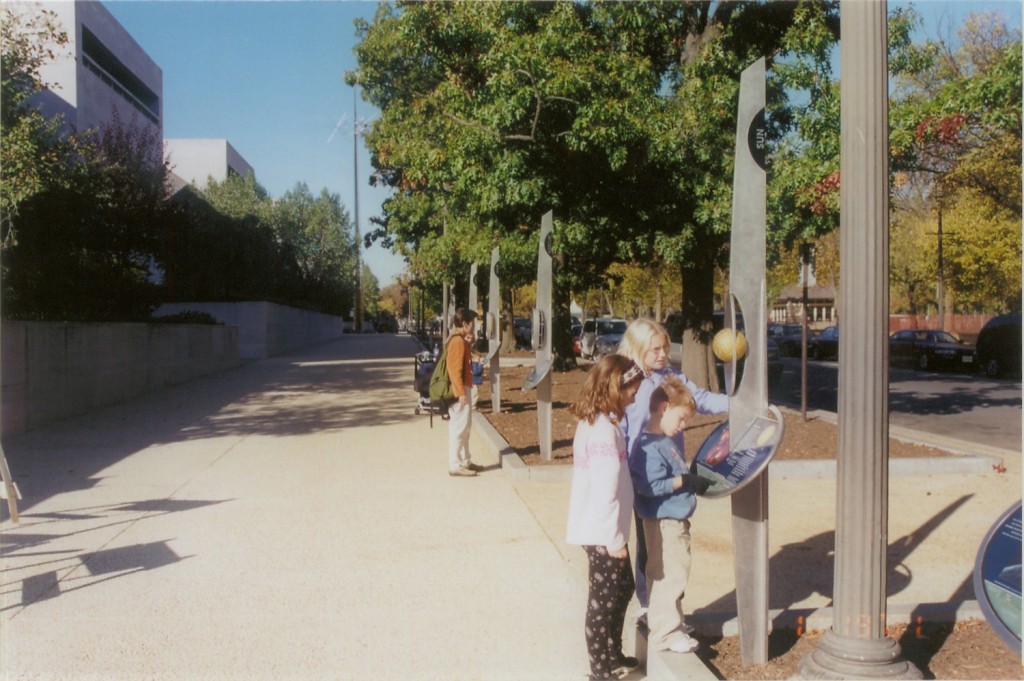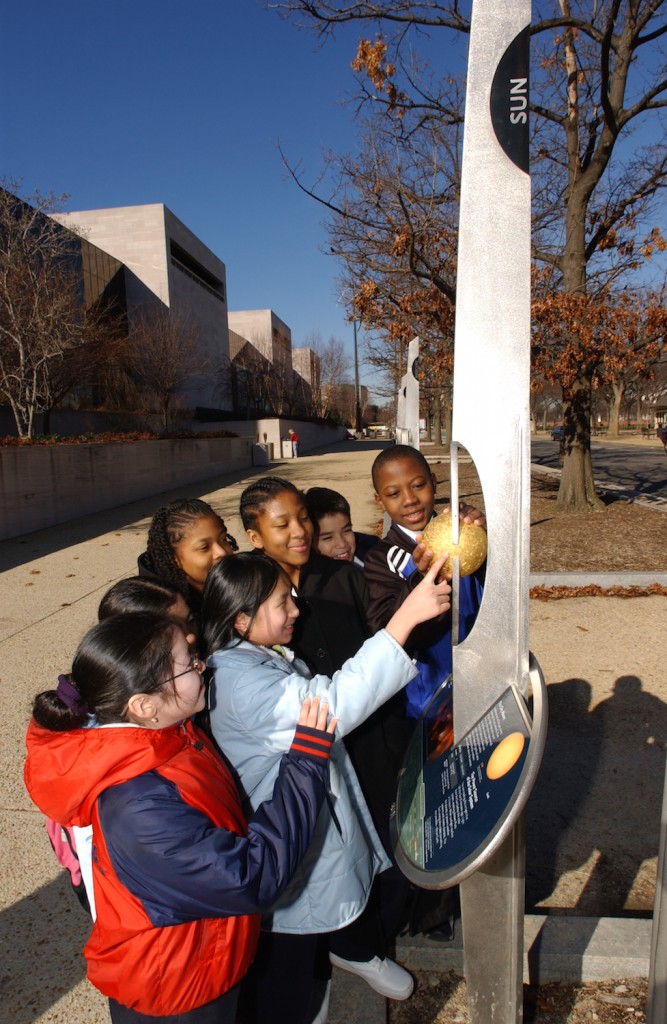
Voyage on the National Mall in Washington, DC, with the Sun and inner Solar System located on the east side of the National Air and Space Museum. You’re looking westward, with Jupiter and Saturn located to either side of the Museum’s main entrance down the street. The dwarf planet Pluto is found 2,000 feet (600 m) from the Sun, near the Smithsonian Castle Building. Beyond is the Washington Monument. If you continue walking you’ll eventually reach the California coast.
Voyage – An Introduction
In October 2001 a 1 to 10-billion scale model of the Solar System was permanently installed on the National Mall in Washington, DC, between the U.S. Capitol and Washington Monument. Appropriately called Voyage, it allows visitors to leave our Earth and gain a profound conceptual understanding of humanity’s place in a greater space. Comprised of 13 stanchions, Voyage is installed along Jefferson Drive, and extends 2,000 feet – a comfortable 10-minute walk – from the model Sun located on the east side of the Smithsonian National Air and Space Museum to the dwarf planet Pluto located at the Smithsonian Castle Building.
Voyage is an accurate model of the Solar System at one ten-billionth actual size. More formally stated, Voyage is a ‘1 to 10-billion scale model’ of the Solar System, where all dimensions depicted – whether it’s the diameters of the Sun, planets, and moons, or the distances between worlds – are one ten-billionth actually size. On this scale, the model Sun is the size of a large grapefruit, with a diameter of 13.9 cm (5.47 inches).
The choice of a 1 to 10-billion scale is based on an assessment of the learning objectives for the visitor experience, with a core objective of most effectively demonstrating that the Solar System is comprised of tiny worlds in a vast space. The exhibition is indeed designed as a voyage that will forever change your perspective of home.
For a physical model of anything to be a good learning tool, it needs to be constructed about the size of a human, so that the learner can manipulate it and explore the real thing as a model. Think of a globe of the Earth, or a model of DNA in a classroom. These physical models are built about our size—close to the size of a human—so we can hold them, manipulate them, and efficiently and effectively explore the information contained in the model. Using a globe of the Earth we can explore the shapes of the continents and oceans, and, e.g., the locations of national borders, mountain ranges, rivers, and cities.
But the Solar System poses a significant problem for the modeler because the distances between worlds are vast compared to the size of the worlds. The best approach is for the size of the learner – the size of a human – to be mid-way between the size of the smallest worlds depicted, and the largest distances depicted. So mid-way between the size of the Moons that have a true diameter of 1,000 km (600 miles) and the Sun-Pluto distance of nearly 6 billion kilometers (3.6 billion miles).
To gain a deeper understanding of our commitment to Voyage’s visitor experience, explore the following pages written by Dr. Jeff Goldstein, Voyage National Program Director. These pages are also found under the Teacher Resources button in the navigation banner at the top of the page –
- the power of models as learning tools
- the use of models in the Voyage exhibition and supporting educational curriculum
- an in-depth explanation of the pedagogy that drove adoption of the 1 to 10-billion scale
- the accuracy of the Voyage scale model solar system
The Visitor Experience

The National Mall in Washington DC, as photographed from Low Earth Orbit. When walking from the US Capitol to the Washington Monument you are moving due west. To view this image at high resolution, first click on it, wait for it to load, then click on the ‘expand’ button located in the image’s upper right corner. Once done, click on the ‘expand’ button again to return to the normal image size.

The site map for Voyage on the National Mall, providing the location of the exhibition’s 13 stanchions relative to local landmarks. Click on the image to zoom.
Imagine leaving the grapefruit-sized Sun walking westward toward the Washington Monument. After walking just 50 feet (15 m) you have already passed Mercury and Venus, and have arrived at Earth, home of the human race, and smaller than the head of a pin. The entire orbit of Earth’s Moon fits comfortably in the palm of your hand. The 50-foot distance between the Earth and Sun represents 17 years of travel at the speed of a commercial jet.
As you continue your journey westward, you fly by Mars and arrive at a marble-sized Jupiter, now 250 feet (77 m) from the model Sun. Looking down at the model Jupiter, the cloud bands on the largest planet are visible in great detail, as is the Great Red Spot—a hurricane-like storm the size of three Earths. A system of rings surrounds the planet, and Jupiter’s 4 largest moons can be seen, with the largest—Ganymede—bigger than the planet Mercury.
Your next destination is nearly twice as far from the Sun as Jupiter. You are now 470 feet (143 m) from the model Sun, when you encounter the planet Saturn, appearing slightly smaller than Jupiter. From the appearance of the cloud bands and intricate rings you see that Saturn is tipped on its side. Four of Saturn’s moons are clearly seen. The largest, Titan—also bigger than the planet Mercury—has an atmosphere thicker than Earth’s.
After a comfortable 20-minute walk, stopping along the way to visit Uranus and Neptune, you arrive at the Smithsonian Castle Building, 6.5 football fields west of the model Sun (2000 ft or 600 m). Here, just visible, is tiny Pluto—far smaller than the head of a pin, and its moon Charon. Looking back at the model Sun, across over 6 football fields of empty space, you realize that Earth is no more than a small speck of dust orbiting close to the Sun. How does the human race—reduced to a species of microbes living on a speck of dust—even know Pluto and Charon exist?
If you could continue your walk westward, you wouldn’t find the nearest star to our Sun—Proxima Centauri, and the size of a grape—until you had reached the California coast.
The Sun and Proxima Centauri are just two stars in our home ‘city of stars’—the Milky Way galaxy. The Milky Way, an insignificant plot of real estate in the greater universe, may contain enough stars to give 50 to every human being on Earth. How insignificant is the Milky Way? It is only one of over 100,000,000,000 galaxies in the observable universe.
The International Space Station orbits the Earth at an altitude of about 250 miles (400 km), and is traveling at a speed of about 18,000 mph (29,000 km/hr)—that’s 5 miles per second (8 km/sec). Light, the fastest thing in the universe, can circle the Earth 7.5 times in one second, traveling 40,000 times faster than the Space Station. The speed of light on the scale of the Voyage model solar system is 1 inch per second (2.5 cm/sec), about the speed of a fast ant. Leaving the model Sun an ant would arrive at the model Earth in eight minutes, Pluto in 6 hours, and a model Proxima Centauri in California after 4.5 years. Put another way—exploring just the space between the Sun and nearest star to the Sun at the fantastic speed of light, would be like exploring the continental United States as a colony of ants.
This is the story of our existence–a race of explorers, 8 billion tiny souls strong. It is a story that ignites wonder about the universe, and a sense of pride in our ability to reveal its nature through both human imagination and ingenuity. It is a story that humbles us, and brings a sense of humility to our lives.
It is a Voyage that will forever change your perspective of home.
You’re invited to listen to Dr. Jeff Goldstein describe the Voyage experience in the video below. Dr. Goldstein is the Director of the Voyage National Program, and the author of the exhibition’s storyboards. He is also the Center Director for the National Center for Each and Space Science Education.
Voyage Exhibition Opening in Kansas City
Dr. Jeff Goldstein, Voyage National Program Director
Kauffman Conversations – highlight interviews with thought leaders whose ideas and insights are changing society
Ewing Marion Kauffman Foundation



